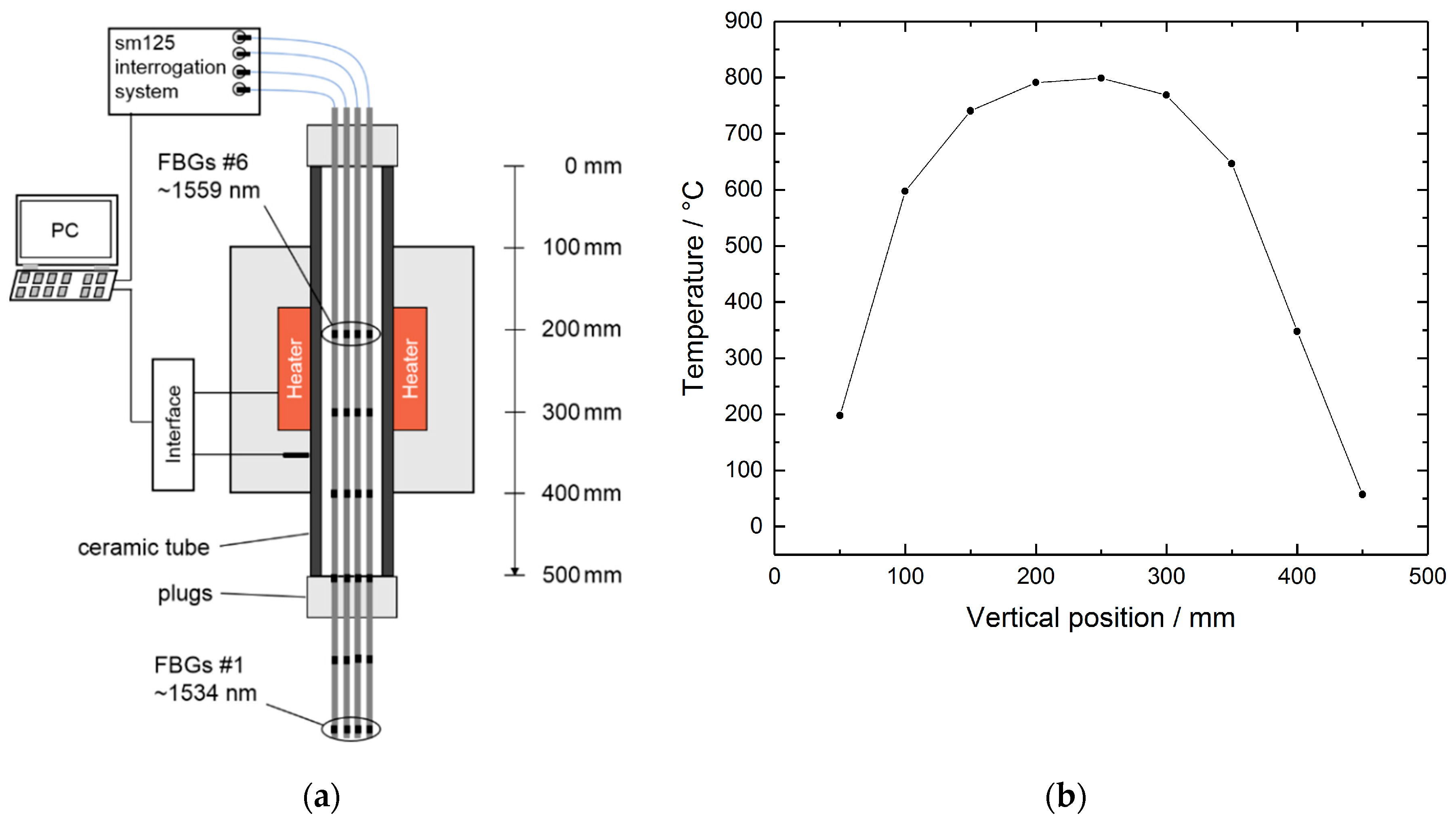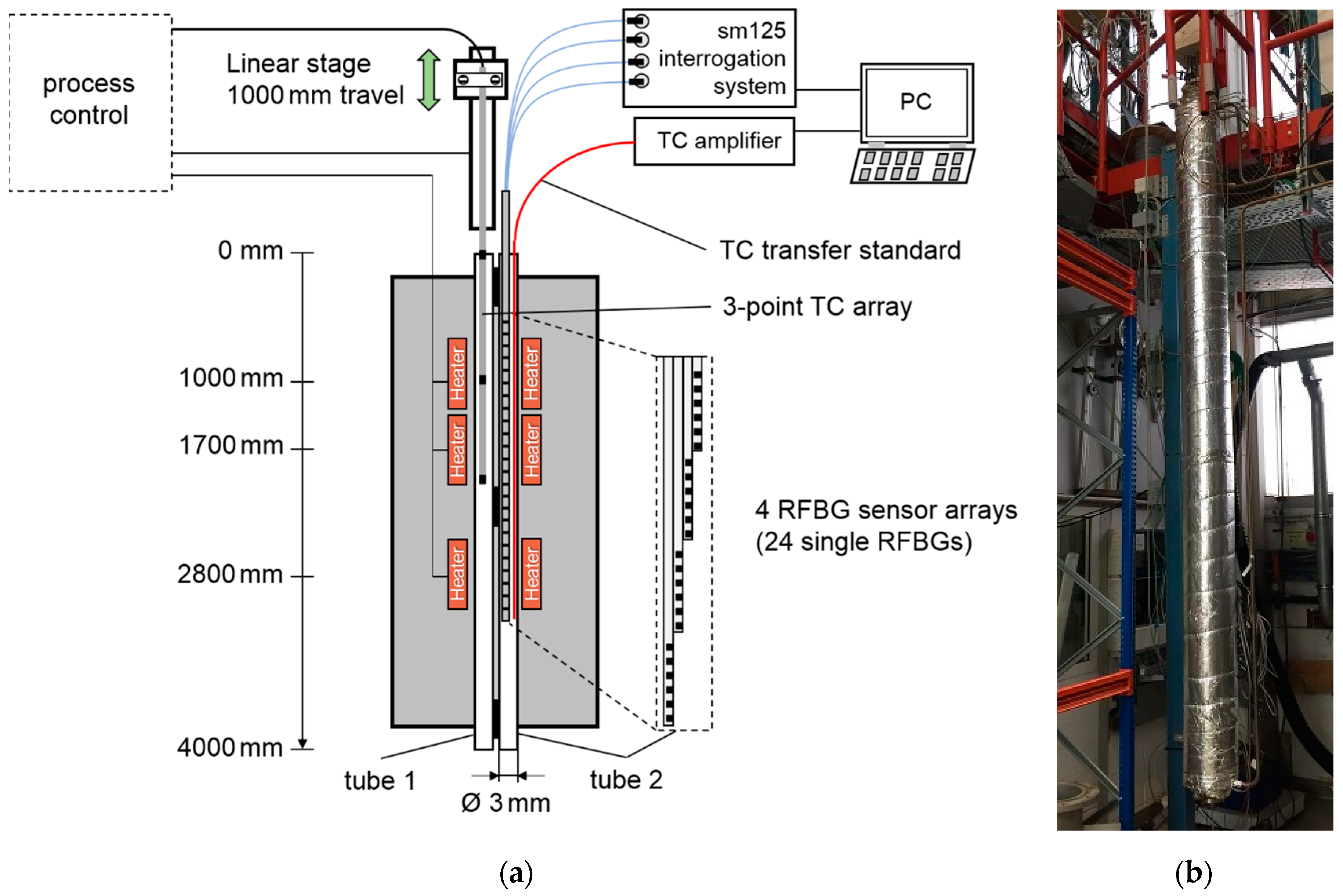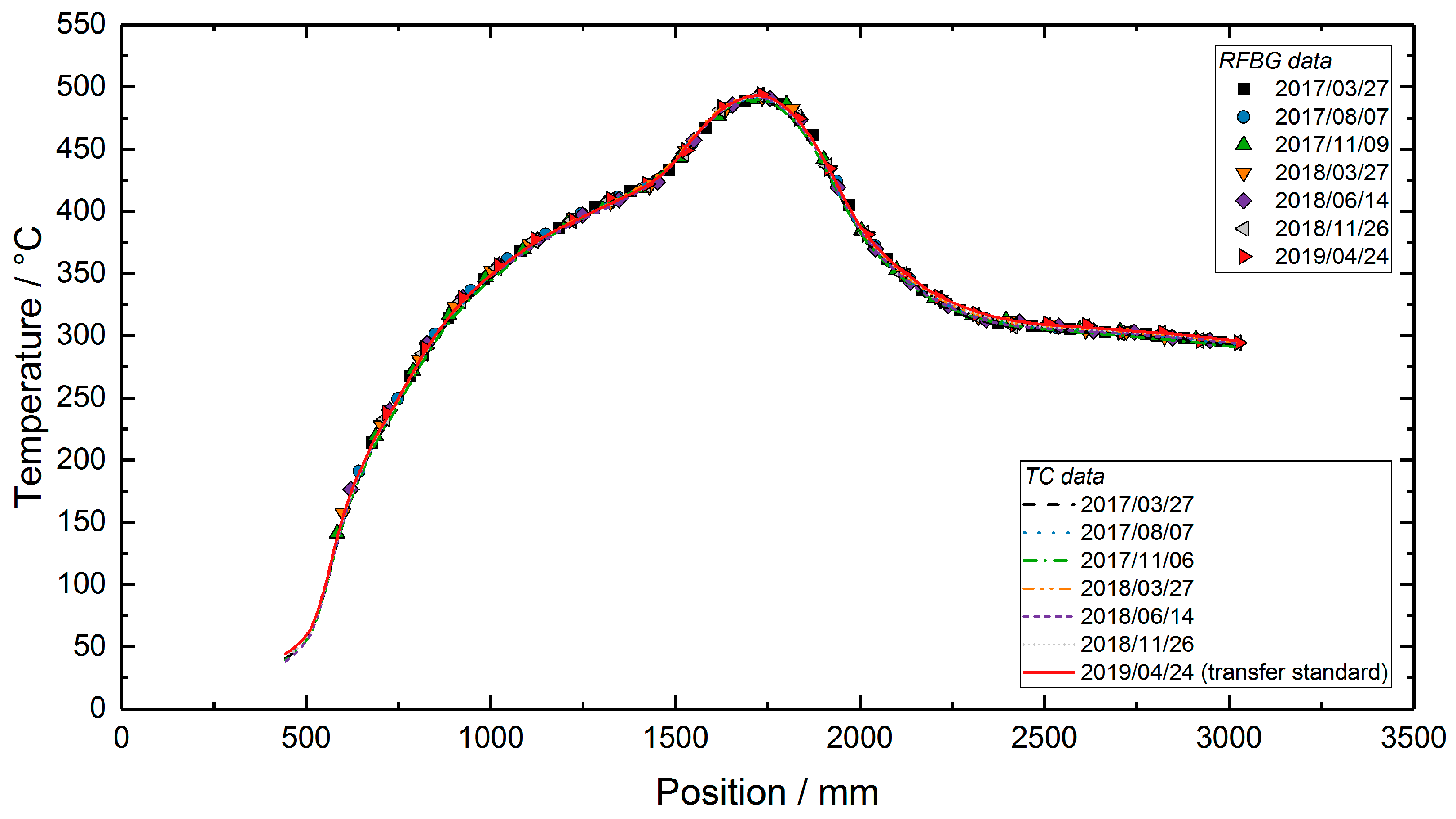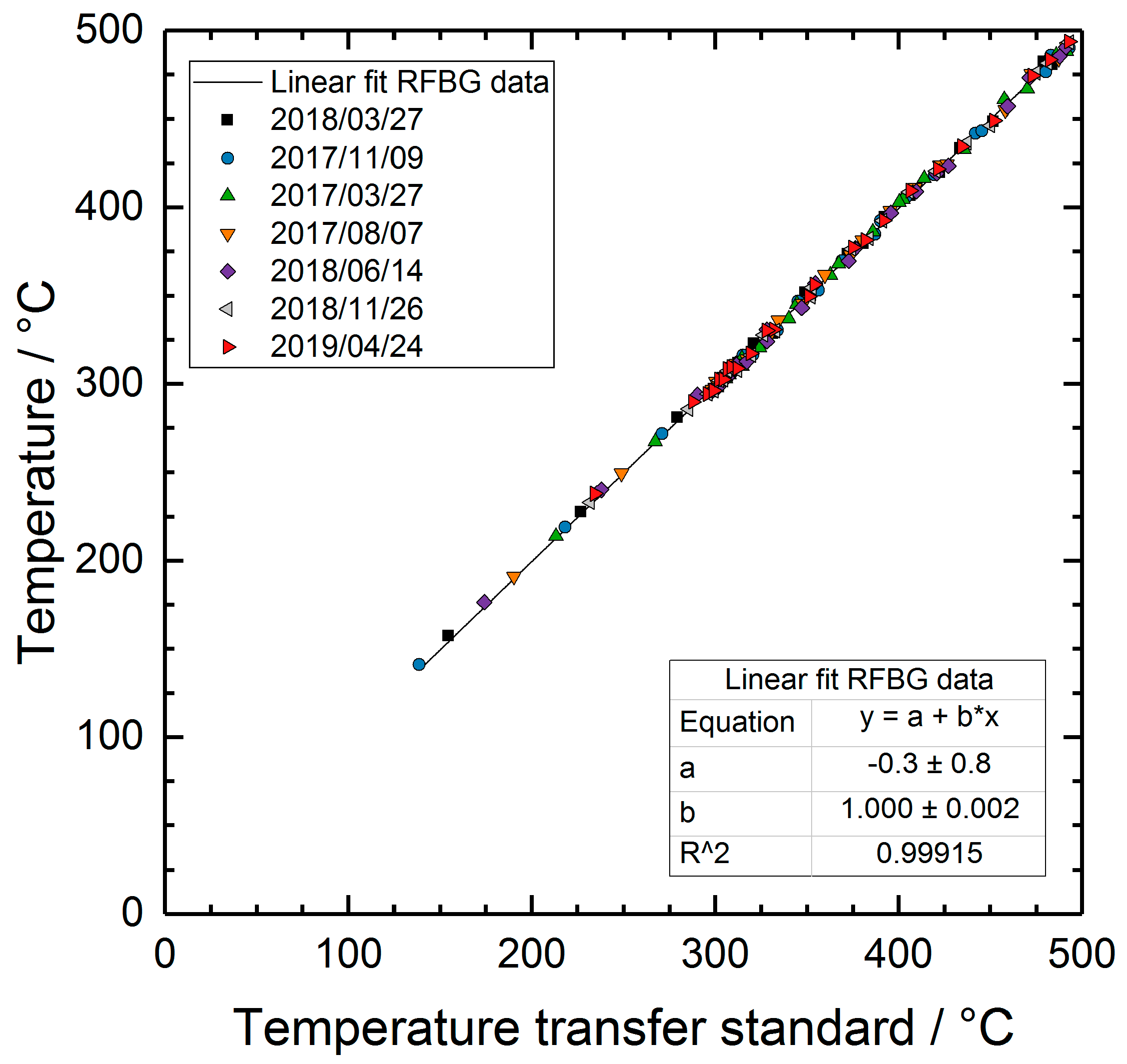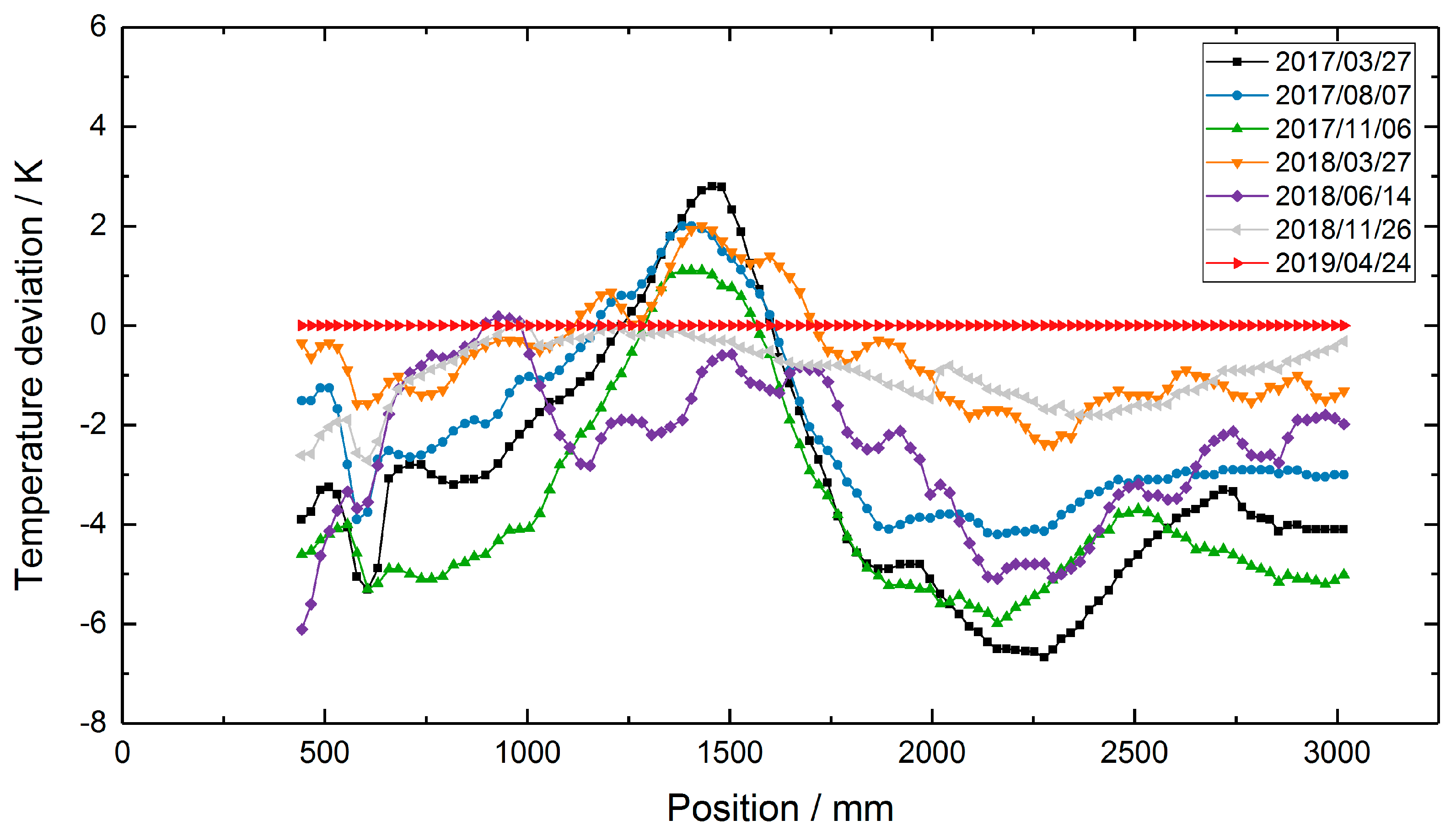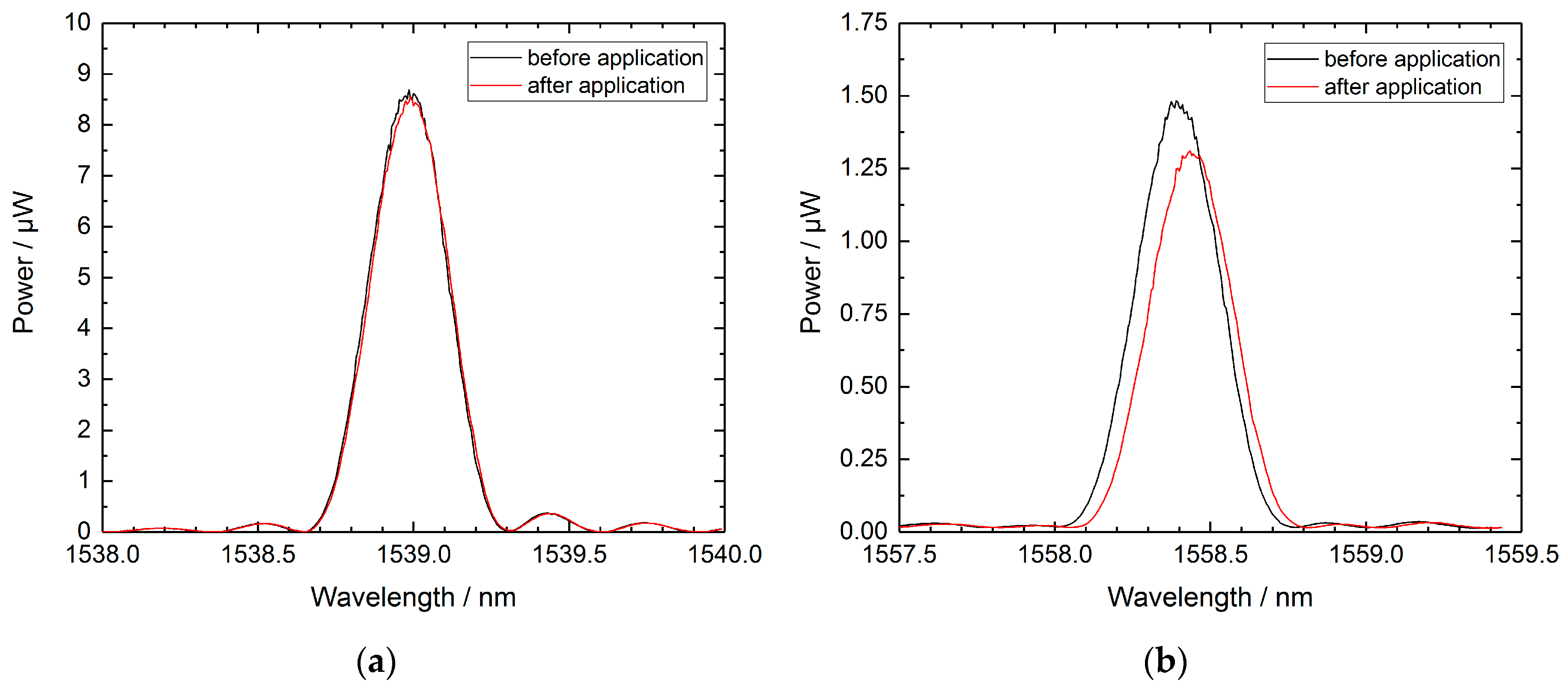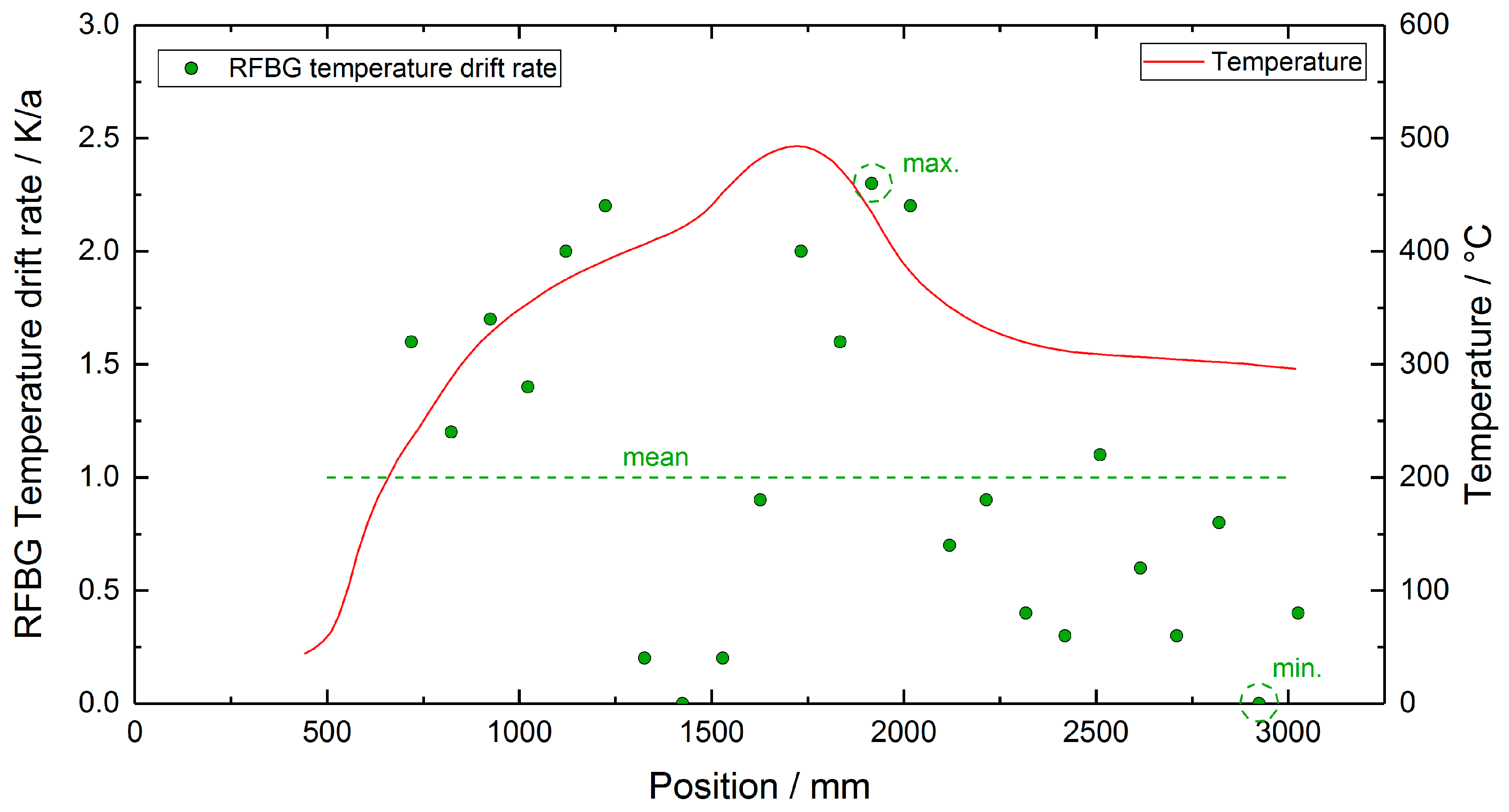1. Introduction
By leaving the laboratory-scale, multipoint fiber-optic temperature sensing based on fiber Bragg gratings has gained significance for industrial applications. The main advantages arise from their immunity to electromagnetic interference, small size, and wavelength multiplexing capability. The latter is of special interest, because it enables a large number of measuring points in a single sensor cable, due to the wavelength-encoded sensor signal. When compared to conventional electrical sensors, such as thermocouples, the technology of multipoint FBG temperature sensing dramatically reduces the cabling efforts.
In many fields of industrial applications, such as chemical reactors or gas turbines, the maximum temperatures exceed 400 °C. This is out of the durability range of standard type I FBGs, because those gratings strongly decay at high temperatures [
1,
2]. Amongst others, type II FBGs inscribed with femtosecond (fs) lasers [
3,
4,
5] and regenerated FBGs (RFBGs) [
6,
7,
8] have been reported to be suitable for temperatures up to 1200 °C. Most often, type II FBGs are inscribed with high-intensity femtosecond laser beams by phase masks (type II-PM) [
3,
9] or by a point-by-point (type II-PbP) [
10] technique, and their main features are a high grating reflectivity, inherent temperature stability, and high initial tensile strength. The disadvantages of type II FBGs arise from their polarization sensitivity [
10,
11] and strong cladding mode coupling [
5,
10], which can limit their multiplexing capabilities. Type II-PbP gratings show significant wavelength drift when exposed to high temperatures [
12,
13]. For type II-PM FBGs, a stabilization of the wavelength drift after an annealing procedure of 100 h at 1000 °C has been reported [
14]. Due to temperature treatments, a thermal-induced glass corrosion and thus a reduction of the tensile strength has to be taken into account.
Regenerated fiber Bragg gratings (RFBGs) emerge from type I gratings in H
2-loaded fibers after an annealing process at temperatures in the range of 800 °C to 1100 °C [
7,
15]. Their uniform spectral line shapes and the lack of cladding mode coupling make RFBGs perfectly suited for multiplexing applications. When compared to type II FBGs, RFBGs typically exhibit lower values of grating reflectivity. However, the high-temperature annealing process that is necessary to form RFBGs leads to a reduction of their tensile strength, but it has the advantageous consequence that this type of high-temperature resistant grating shows low drift rates of the Bragg wavelengths when compared to type II-PbP FBGs [
12,
13]. The issue of the mechanical robustness of the fiber-optic sensor system has to be addressed with appropriate sensor packaging and with specific measures during the annealing process. For the application reported in this article, the priority lies in the low drift characteristics and the multiplexing capabilities, and this is why we use regenerated gratings here.
So far, industrial employments of regenerated and type II grating-based multipoint sensing have been reported for gas turbines [
12,
16,
17], various combustor systems [
5], nuclear reactors [
13] and a test facility of the chemical industry [
12]. In the chemical industry, catalytic fixed-bed reactors are widely used for the large-scale synthesis of basic chemicals and intermediates such as methanol, phthalic anhydride [
18], and maleic anhydride [
19]. Another emerging field of application lies in the production of synthesis gas and substitute natural gas (methanation) for carbon dioxide reduction purposes [
20]. Common arrangements of catalytic fixed-bed reactors are tubular reactors, where the chemical conversion takes place in the form of heterogeneously catalyzed gas-phase reactions in 3 m to 10 m long, vertically oriented reaction tubes, which are filled with catalyst particles and a heat transfer medium (e.g., molten salt) which externally circulates the reaction tubes [
21]. Generally, the quantity of the tubes varies in dependence on the purpose, such as from one tube in pilot-scale plants, where the optimal process parameters concerning output, efficiency and product quality are determined, to several ten thousand tubes in the subsequent tube bundle reactors for large-scale production [
21].
With strongly exothermic successive reactions, such as partial oxidations, reaction kinetics lead to the development of a characteristic axial temperature profile with a pronounced temperature maximum (a so-called hot spot), typically located close to the inlet of the reactor [
21]. Especially during the start-up process, there is a risk of a runaway reaction, which means that the reaction changes from, for example, conversion to the desired product to total combustion of the reactants, and thus the hot spot temperature rapidly increases to values far beyond 700 °C [
21]. In addition, the reaction front may move to the reactor entrance within a few seconds and can cause detonation, resulting in serious damage to the catalyst and the facility [
21]. Therefore, in reactors bearing temperature-sensitive and critical processes, there is a need for fast measurements of the axial temperature distribution over the complete vertical extension of the reactors, with a high spatial resolution for localizing and preventing critical process conditions. This enables an optimal start-up process, but, on the other hand, the long-term stability is also of utmost importance. A fixed-bed reactor operates continuously without any shut-down during the lifetime of the catalysts, which is typically several years. During this period, the sensor system should maintain uncertainties of a few degrees and no recalibration or replacement of the sensor system should be necessary.
To gain access for temperature measurement, selected reactor tubes are axially equipped with protective tubes that demarcate the temperature probe from the reaction volume. The outer diameters of the protective tubes have to be as small as possible to ensure representative conditions when compared to unequipped reactor tubes. Conventionally, the temperature measurements are performed with single- or multi-point thermocouples that are inserted in the protective tubes, and the available cross section strongly limits the number of thermocouples. An increase in the spatial resolution is possible by axially moving the thermocouples via an automatic positioning device [
22]. This enlarges the acquisition time for the complete profile to several minutes and it means that there is a systematic time offset of a few minutes within the measured temperatures of a profile. Besides, the mechanism is mechanically sensitive, and the space required is usually too much to be applicable in industrial facilities. In contrast, fiber-optic multipoint temperature sensing allows measuring the axial temperature distribution with both high spatial and high temporal resolution simultaneously, combined with miniaturized sensor design and high accuracy [
12]. This technology is particularly attractive for industrial process control [
23].
In this article, we demonstrate the suitability of multipoint RFBG sensing for applications in catalytic fixed-bed tubular reactors by measuring high-temperature profiles over a length of 2.3 m in a representative industrial environment for more than two years. The issues addressed here are the design of the sensor packaging, the measurement accuracy, and the validation of the RFBG-based temperature data with thermocouples.
Moreover, the verification of the long-term stability, regarding mechanical robustness and temperature drift of the fiber-optic sensor system is of special interest, because these characteristics are generally important for industrial applications. For the measurements, we used a 4-m-long pilot reactor from MAN Energy Solutions SE in Deggendorf, Germany. Here, three electrical heaters created a typical temperature distribution along two parallel protective tubes, with temperatures of up to 500 °C. In the first protective tube, there was a conventional temperature measurement system based on moveable thermocouples for reference data. In the second protective tube, a RFBG multipoint temperature sensor system consisting of 24 elements evenly distributed over 2.3 m was installed. For more than two years, temperatures were kept constant and repeated measurements of the axial temperature profile were carried out. A description of the production process of the RFBG sensor arrays, including the regeneration procedure and the sensor calibration, is given below. Subsequently, the test setup is shown in detail and the results of the long-term measurements are presented. Concluding, the results are discussed in matters of temperature accuracy and temperature drift.
3. Long-Term Deployment in a Tubular Pilot Reactor
For demonstrating the suitability of RFBG fiber sensors for long-term temperature profile sensing in tubular reactors, we deployed the RFBG sensor arrays in a pilot test reactor as shown in
Figure 4. This setup enabled the generation of temperature profiles, which were typical for catalytic gas-phase reactions regarding the temperature range and the spatial extension. Electrical heaters at three different vertical positions (~1000 mm, ~1700 mm, ~2800 mm) created a vertical temperature profile along two parallel, closely-spaced protective tubes, each of about 4000 mm in length and 3 mm in inner diameter (
Figure 4a). The tubes were welded on each other at spots on the top, middle, and bottom of the reactor. In the first protective tube (tube 1), an array of three type K thermocouples (TC) of a 2 mm outer diameter and tolerance class 1 (Rössel-Messtechnik GmbH, Werne, Germany) was installed. The TC sensor array was mounted on a linear stage capable of one-meter travel (
Figure 4a) and the elements were separated by one meter. With this translation mechanism, it was possible to measure the vertical temperature profiles over a total range of 3000 mm with a high spatial resolution by shifting the thermocouples vertically inside the protective tube [
22]. The vertical step size was set to 20 mm and the dwell time at each position was two minutes. This allowed the system to achieve thermal equilibrium before the temperature measurement was performed with the thermocouples. The time needed for acquiring a complete temperature profile was 100 minutes.
In the second protective tube (tube 2), the four RFBG sensor arrays were installed with vertical offsets to each other, so the 24 RFBG elements covered a length of 2300 mm with spacings between adjacent measurement points of about 100 mm (see the inset of
Figure 4a). The diameter of the four stacked RFBG arrays was less than 2 mm. It is worth noting that the length of the fiber-optic sensor can be easily extended by adding additional RFBG arrays. A four-channel sm125 interrogation system (Micron Optics, Atlanta, USA) provided the RFBG spectral data. The temperature values were automatically calculated from the measured Bragg wavelengths by numerically inverting the fifth-order polynomial calibration function, expressed in Equation (1). The time needed to acquire a complete temperature profile with the RFBG arrays was about one second.
During the long-term deployment, the three heaters were set to constant temperature values of 350 °C, 500 °C and 300 °C, respectively. From March 2017 to April 2019, the test facility was kept at this constant temperature profile and the RFBG sensor arrays remained inside the facility at high temperatures. Seven individual measurements of the temperature profile were performed during the two-year period at intervals of three to five months. During the last measurement on 24 April 2019, an additional calibrated thermocouple with an outer diameter of 0.5 mm (TC Mess-und Regeltechnik GmbH, Mönchengladbach, Germany) was used as a transfer standard. It had a temperature uncertainty of ±2.0 K at 500 °C and was inserted in tube 2 (
Figure 4a) beside the RFBG arrays. This thermocouple was manually shifted in steps of 20 mm to obtain the axial temperature distribution with high accuracy. This measurement was done to identify systematic uncertainties, such as possible temperature gradients between both protective tubes. By subtracting the TC transfer standard data (tube 2) from the TC array data (tube 1) of the same day (24 April 2019), position-dependent temperature deviations of up to 10 °C between both tubes were obtained (
Figure 5). Then, these values were used to correct the TC-based temperatures measured in tube 1 at the other days. During the operating period of more than two years (758 days), several workings on the pilot plant were carried out. As a result, the external parts of the RFBG sensor arrays were subjected to strong agitations. This caused vertical shifts of the RFBG sensor arrays, and their positions relative to the protective tube changed by up to 100 mm between successive measurements. For each measurement, the locations of the RFBG arrays were determined and the appropriate position of each RFBG sensor element was updated.
Figure 6 depicts the results of the long-term deployment. It shows all temperature profiles measured by the RFBG sensor system and the corrected data of the moveable three-point TC array at the respective dates. The RFBG-based temperature data are in good accordance with the corrected TC-based data. After two years of operation, we removed the RFBG sensor system from the pilot reactor and brought it back to the laboratory for investigating possible wavelength drifts (see
Section 4).
4. Discussion
In order to check the employed calibration function, all the RFBG-based temperatures measured during the two-year deployment were related to the transfer standard temperatures obtained on 24 April 2019.
Figure 7 shows the resulting plot with a linear function fitted to the data. The slope and the offset of the linear fit equates with (1.000 ± 0.002) K and (−0.3 ± 0.8) K, respectively. This demonstrates that the calibration function was valid during the long-term application.
To assess the sensor performance in terms of temperature accuracy, the temperature profile measured with the TC transfer standard on 24 April 2019, was subtracted from the temperature profiles of the RFBG sensor system (see
Figure 8). If there was no measuring point at the same position, the corresponding temperature of the single-point TC transfer standard was calculated by linear interpolation between two neighboring values.
Figure 8 depicts the temperature deviations between the transfer standard and the RFBG data. Here, the differences were in the range of ±4 K. The deviations of ±4 K in the RFBG data are within the uncertainty of the RFBG calibration procedure (±4.5 K, see
Section 2.3). In addition to that, a drift of the RFBG sensors or instabilities of the setup might also contribute to the observed differences.
In order to further characterize the setup used and the three-point TC array, the three-point TC array data were corrected for the temperature differences between tube 1 and tube 2.
Figure 9 shows the differences of all corrected three-point TC data taken during the two-year campaign and the single-point TC data from 24 April 2019. These differences are in the range of +3 K to −7 K and thus slightly larger than those of the RFBG-based data.
Due to the uncertainties in the calibration procedure, the data shown in
Figure 7 and
Figure 8 give no clear evidence of a temperature drift in the RFBG sensors. In order to investigate a possible sensor drift of the RFBGs, the RFBG arrays were removed from the test reactor, brought back to the laboratory, and the spectra of the RFBG arrays were measured at a reference temperature with the same setup and procedure that was used before the deployment (see
Section 2.3). In
Table 2 there is a summary of the Bragg wavelengths at reference temperature measured before and after the installation in the test reactor. It can be seen that all RFBG elements still functioned when back in the laboratory and wavelength shifts between 0 pm and 48 pm occurred during the two years at high temperatures.
Figure 10 exemplarily shows the spectra of the best and worst cases found: RFBG #2 of array A1 seems to be completely unaltered (see
Figure 10a), whereas RFBG #6 of array A2 comprises a slight degradation of its reflectivity and it showed a wavelength shift of 48 pm (see
Figure 10b). When considering a sensitivity of 10 pm/K at reference temperature, this corresponds to a temperature drift of 0 K to 4.8 K during 758 days of operation at high temperatures.
Table 2 also lists the temperature drift per year (365 days), as calculated by linear interpolation. In order to check, if the drift depends on the temperature employed,
Figure 11 depicts the drift rates of the RFBGs together with the long-term temperature profile. In
Figure 11, no distinct dependency of the drift rate on the long-term operating temperature can be found. The drift rates range from 0.0 K/a to 2.3 K/a, and the average amounts to 1.0 K/a.
So far, there are only a few publications on the drifts of RFBGs at high temperatures that are based on time scales of one year or more. In [
13], Laffont et al. reported on the long-term annealing of four packaged RFBG sensors at temperatures ranging from 760 °C to 890 °C. After 9000 h of isothermal annealing, the RFBG elements experienced wavelength shifts larger than 500 pm, corresponding to temperature drift rates of more than 30 K/a [
13]. This is considerably higher than the maximum drift rate of 2.3 K/a found in the present study, but this may be attributed to the significantly higher operating temperatures in [
13].

